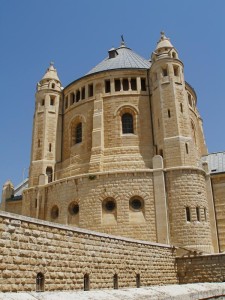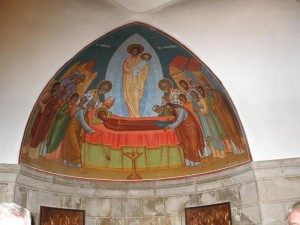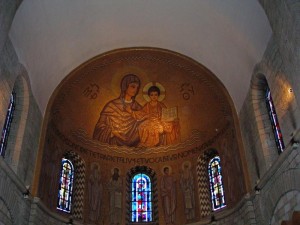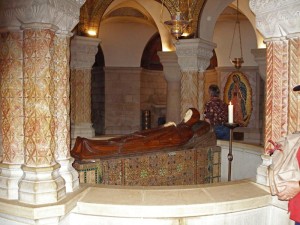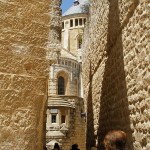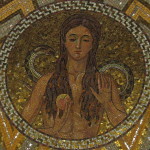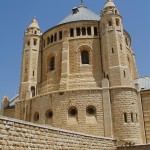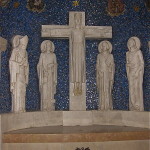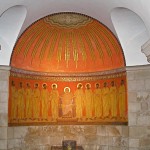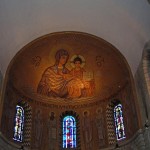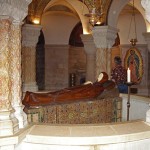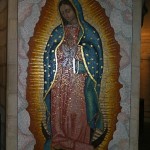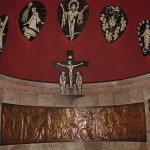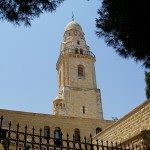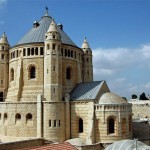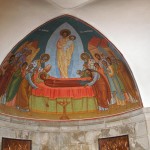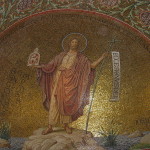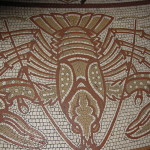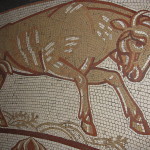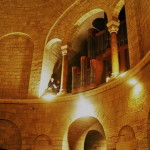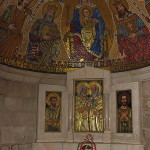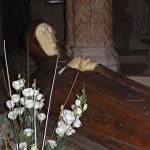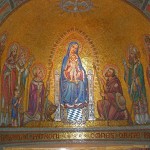Jerusalem
The hill of Mount Zion, the highest point in ancient Jerusalem, is dominated by the Church of the Dormition. The location is identified in Christian tradition as the place where the Virgin Mary died — or “fell asleep”, as the name suggests.
The fortress-like building, with a conical roof and four corner towers, stands south of the Old City’s Zion Gate. Nearby soars the bell tower of the Hagia Maria Sion Abbey (formerly the Abbey of the Dormition), a Benedictine monastery.
During the Byzantine period, the Church of Hagia Sion (Holy Zion), one of the three earliest churches in Jerusalem, stood on this site. Built by the Emperor Constantine, it was regarded as the Mother of all Churches. In AD 614 it was destroyed by the Persians.
Claims made for two cities
Two cities, Jerusalem and Ephesus (in present-day Turkey), claim to be the place where the Virgin Mary died. The Ephesus claim rests in part on the Gospel account that Christ on his cross entrusted the care of Mary to St John (who later went to Ephesus).
But the earliest traditions all locate the end of Mary’s life in Jerusalem, where the Tomb of Mary is venerated at the foot of the Mount of Olives.
Accounts of Mary’s death in Jerusalem appear in early sources such as De Orbitu S. Dominae, Transitus Mariae and Liber Requiei Mariae. These books are described as apocryphal (meaning “hidden” or “secret”). Their authenticity is uncertain and they are not accepted as part of the Christian canon of Scripture.
But, according to biblical scholar Lino Cignelli, “All of them are traceable back to a single primitive document, a Judaeo-Christian prototype, clearly written within the mother church of Jerusalem some time during the second century, and, in all probability, composed for liturgical use right at the Tomb of Our Lady.
“From the earliest times, tradition has assigned the authorship of the prototype to one Lucius Carinus, said to have been a disciple and fellow labourer with St John the Evangelist.”
By the reckoning of Transitus Mariae, Mary would have been aged no more than 50 at the time of her death.
Early writers favour Jerusalem
The early sources are summarised in this way by the Catholic Encyclopedia:
“The apocryphal works of the second to the fourth century are all favourable to the Jerusalem tradition. According to the Acts of St John by Prochurus, written (160-70) by Lencius, the Evangelist went to Ephesus accompanied by Prochurus alone and at a very advanced age, i.e. after Mary’s death.
“The two letters B. Inatii missa S. Joanni, written about 370, show that the Blessed Virgin passed the remainder of her days at Jerusalem. That of Dionysius the Areopagite to the Bishop Titus (363), the Joannis liber de Dormitione Mariae (third to fourth century), and the treatise De transitu B.M. Virginis (fourth century) place her tomb at Gethsemane . . . .
“There was never any tradition connecting Mary’s death and burial with the city of Ephesus.”
Belief in the Assumption
The belief that the Virgin Mary was bodily assumed into heaven is mentioned in the above books and also in authenticated sermons by Eastern saints such as St Andrew of Crete and St John of Damascus.
The Assumption of Mary has been a subject of Christian art for centuries (and its feast day was made a public holiday in England by King Alfred the Great in the 9th century). It was defined as a doctrine of the Catholic Church by Pope Pius XII in 1950.
St John of Damascus describes the origin of this belief in these words:
“St Juvenal, Bishop of Jerusalem, at the Council of Chalcedon [AD 451], made known to the Emperor Marcian and Pulcheria, who wished to possess the body of the Mother of God, that Mary died in the presence of all the apostles, but that her tomb, when opened, upon the request of St Thomas [who arrived late], was found empty; wherefrom the apostles concluded that the body was taken up to heaven.”
The Eastern Orthodox churches celebrate the feast of the Dormition of the Mother of God on August 15, the same day that the Catholic Church and some Protestant churches celebrate the feast of the Assumption of Mary.
Land was given by sultan
The land on which the Church of the Dormition stands was given in 1898 by the Turkish Sultan Abdul Hamid II to Kaiser Wilhelm II of Germany, who presented it to the Catholic Church. Construction was completed in 1910.
Like the Crusader church that preceded it, the basilica is built on two levels with the high altar and monastic choir on the upper of these, and the crypt with its Marian shrine on the lower.
Light from several large windows pours into the upper level, and colourful wall mosaics depict events from Christian and Benedictine history.
High above the main altar is a mosaic of Mary and the infant Jesus. The Latin inscription below it is from Isaiah 7:14: “Behold, a virgin shall conceive, and bear a son, and shall call his name Immanuel.”
Life-size statue of Mary in death
If the upper floor of the Church of the Dormition is luminous, the circular crypt seems totally shrouded when first entered.
In the centre, under a rotunda, is a simple bier on which rests a life-size statue of Mary, fallen asleep in death. The statue is made of cherry wood and ivory.
The dome above the statue is adorned with mosaic pictures of six women of the Old Testament: Eve, Miriam, Jael, Judith, Ruth and Esther.
In the 1948 Arab-Israeli War, the church was seriously damaged by military bombardment. During the 1967 Six Day War, Israeli forces took possession of the building and the Mother and Child mosaic in the apse received a barrage of machine-gun bullets from the interior of the church.
The Dormition Church has a fine organ, which is often used for concerts.
Related site:
Administered by: Benedictine Order
Tel.: 972-2-5655330
Open: Mon-Fri 8.30-11.45am, 12.40-5.30pm; Sat 8.30-11.45am, 12.40-2.45pm, 3.30-5.30pm; Sun 10.30-11.45am, 12.30-5.30pm
- Glimpse of Church of the Dormition (Seetheholyland.net)
- Mosaic of Eve in Church of the Dormition (© Deror Avi)
- Dome of Church of the Dormition (Seetheholyland.net)
- Chapel in Church of the Dormition (© Deror Avi)
- Twelve apostles around altar in the Church of the Dormition (Seetheholyland.net)
- Mary and Jesus mosaic in the Church of the Dormition (Seetheholyland.net)
- Lifesize image of Mary in death, in the Church of the Dormition (Seetheholyland.net)
- Our Lady of Guadalupe image in Church of the Dormition (© Tom Callinan / Seetheholyland.net)
- Chapel donated by Ivory Coast, in Church of the Dormition (© Deror Avi)
- Tower of Dormition Abbey (Seetheholyland.net)
- Abbey of the Dormition (© Israel Ministry of Tourism)
- Apostles at the death of Mary, in the Church of the Dormition (Seetheholyland.net)
- John the Baptist mosaic in Church of the Dormition (© Deror Avi)
- Zodiac mosaic of Cancer the crab in Church of the Dormition (© Deror Avi)
- Zodiac mosaic of Taurus the bull in Church of the Dormition (© Deror Avi)
- Organ in Church of the Dormition (© Ester Inbar / Wikimedia)
- Chapel donated by Hungary, in Church of the Dormition (© Deror Avi)
- Close-up of image of Mary (© Deror Avi)
- Mosaic of Ruth in Church of the Dormition (© Deror Avi)
- Visiting saints paying homage to Mary, in the Church of the Dormition (Seetheholyland.net)
References
Bar-Am, Aviva: Beyond the Walls: Churches of Jerusalem (Ahva Press, 1998)
Maas, Anthony: “The Blessed Virgin Mary”, The Catholic Encyclopedia (Robert Appleton Company, 1912).
Gonen, Rivka: Biblical Holy Places: An illustrated guide (Collier Macmillan, 1987)
Petrozzi, Maria Tereza: “The Place of Mary’s Dormition”, Holy Land, spring 2005
Wareham, Norman, and Gill, Jill: Every Pilgrim’s Guide to the Holy Land (Canterbury Press, 1996)
External links

